HISTORY OF IRAN (PERSIA)
The Medes and the Persians: from the 9th century BC
Of the two main Indo-European tribes moving south into Iran, it is at first the Medes who play the dominant role. With a capital at Ecbatana (modern Hamadan), they establish themselves as powerful neighbors of Assyria. In 612 they combine with Babylon to sack the Assyrian capital at Nineveh. Their spoils are northern Assyria and much of Anatolia, where the Halys river becomes the border between themselves and Lydia.
The Medes already control much of Iran including Fars, in the southwest. This is the heartland of the Parsa or Persians, whose king is a vassal of the Medes - and from whose name the region has until recently been known as Persia in the west.
Cyrus the Great: 559-530 BC
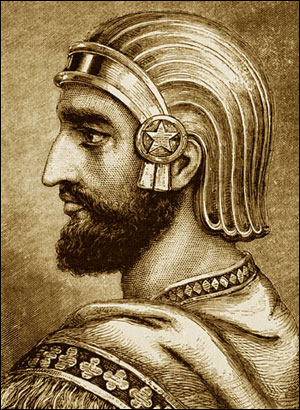 The balance between the Medes and the Persians rapidly changes after Cyrus II becomes king of the Persians in 559 BC. He rebels against the Medes in 553. Three years later he captures their king and their capital city, Ecbatana. He then presses west to secure and expand his new empire. He seizes the Lydian capital, Sardis, in 546, together with Croesus, its famously rich king. His armies then continue west to dominate the Greek cities of Ionia, extending his power to the shores of the Aegean.
The balance between the Medes and the Persians rapidly changes after Cyrus II becomes king of the Persians in 559 BC. He rebels against the Medes in 553. Three years later he captures their king and their capital city, Ecbatana. He then presses west to secure and expand his new empire. He seizes the Lydian capital, Sardis, in 546, together with Croesus, its famously rich king. His armies then continue west to dominate the Greek cities of Ionia, extending his power to the shores of the Aegean.
Babylon and Mesopotamia fall to him next, in 539. The basis of the first Persian empire (the Achaemenid empire) has been set in place within a mere eleven years of Cyrus defeating the Medes. He has earned his title 'the Great'.
Cyrus is a politician as well as a conqueror. He presents himself as liberator of Babylon, releasing the people from the yoke of an unpopular king, and he is received as such. He makes a point of respecting the Babylonian religion. He allows the Jews to return from their Babylonian captivity to Jerusalem, and encourages the rebuilding of their Temple.
There is in these actions a genuine basis for his reputation. But Cyrus also uses propaganda more successively than any previous ruler, to spread and reinforce his fame. People succumb to this conqueror partly because they believe it in their interest to do so.
Cyrus dies in 530, campaigning against nomadic tribesmen in the northeast, near the Oxus and Jaxartes rivers. He is buried in the place which he has made his capital, Pasargadae.
His tomb, massive but superbly simple, stands today as an impressive monument to the emperor - though now in parched surroundings where once everything was well watered, in an early version of a Persian garden. Its interior, in which the body lies in a gold sarcophagus on a gold couch, is broken into and stripped two centuries after his death during the campaign of Alexander the Great.
The brief reign of Cyrus's son, Cambyses II, includes another important extension of the empire. He defeats the Egyptians in battle, at Pelusium in 525, and enters their capital city at Memphis. Egypt becomes the province of a Persian satrap.
In Cambyses' absence the throne in Persia is seized by a rebel. On the way home to challenge him, Cambyses dies. A cousin of his leads the attack, kills the impostor and takes the throne. He is Darius.
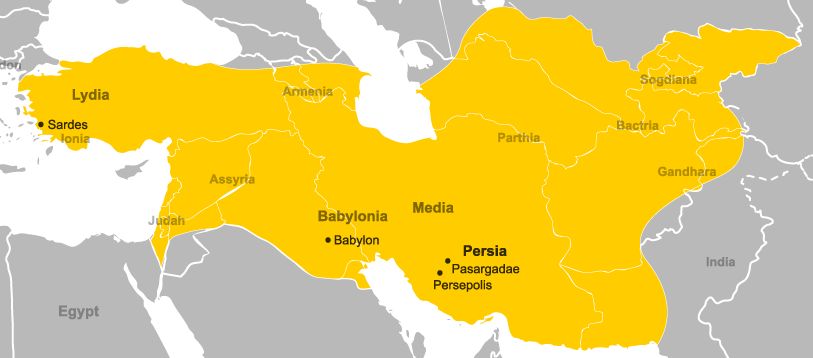
Darius: 522-486 BC
During the long rule of Darius I, the conquests of Cyrus and Cambyses are consolidated and the Achaemenid Empire reaches its greatest extent - from Macedonia in the west to northern India in the east. Never before has such a large area, including so many people of different cultures and traditions, been controlled under a single system.
The genius of Darius lies in creating a workable structure for the empire. This depends on such details as a sustainable system of taxation; a communication network based on good roads and efficient message-carrying; a single language, Aramaic, used in government documents throughout the empire; and firm control in the armed forces.
The Persian Empire: c.500 BC
The Persian system of taxation is tailored to each satrapy (the area ruled by a satrap, or provincial governor). At differing times there are between 20 and 30 satrapies in the empire, and each is assessed according to its supposed productivity. It is the responsibility of the satrap to collect the due amount and to send it to the emperor, after deducting his expenses. (The expenses and the power of deciding precisely how and from whom to raise the money in the province, offer maximum opportunity for rich pickings.)
Babylon is assessed for the highest amount, and for a startling mixture of commodities - 1000 silver talents, four months' supply of food for the army, and 500 eunuchs. India, clearly, is already fabled for its gold; the province is to supply gold dust equal in value to the very large amount of 4680 silver talents. Egypt is known for the wealth of its crops; it is to be the granary of this empire (as later of Rome's) and is required to provide 120,000 measures of grain in addition to 700 talents of silver.
This is exclusively a tax levied on subject peoples. Persians and Medes pay no tax. But they are liable at any time to serve in the army.
The Persian army: c.500 BC
The regular army of the Persian empire contains an elite corps involving a brilliant element of propaganda. These crack troops are known as the Immortals, for the simple and inspired reason that there are always 10,000 of them (in theory as soon as one dies, another soldier is ready to take his place). At the heart of this 10,000 are an even more special thousand - the royal bodyguard.
The army is precisely decimal. Divisions of 10,000 are divided into battalions of 1000, companies of 100 and squads of 10. The bow is the chief Persian weapon, and the armies' tactics are based on rapid movement and light armour.
Imperial communication: 522-486 BC
Darius extends the network of roads across the Persian empire, to enable both troops and information to move with startling speed. At the centre of the system is the royal road from Susa to Sardis, a distance of some 2000 miles (3200 km). At intervals of a day's ride there are posting stations, where new men and fresh horses will be available at any moment to carry a document on through the next day's journey. The Greek historian Herodotus marvels at these Persian couriers.
By this method a message can travel the full distance of the road in ten days, at a speed of about 200 miles a day. A similar road goes down through Syria to the Mediterranean coast and Egypt. Another goes east to India.
Many different tongues are spoken in the Persian empire, from Egypt to India. But all the official messages travelling on the imperial roads are in one language, Aramaic. This Semitic tongue, deriving from a tribe in northern Syria, first spreads through Assyria. Then Babylonian merchants carry it further afield until, by the 6th century, it is in general use as a Lingua franca throughout Mesopotamia.
As a language for the Persian civil service, Aramaic also has a practical advantage. It uses the Phoenician alphabet, a language to which it is related. So its letters can be written on papyrus (easily portable) instead of needing to be pressed with a cuneiform stylus into wet clay.
The architecture of empire: 522-486 BC
As well as setting in place the administrative structure of the empire (and adopting Zoroastrianism as the state religion), Darius proves himself the greatest builder of the Achaemenid dynasty. In 521 he moves his capital to Susa, building there an audience hall and a palace. An inscription found at Susa reveals his pride in his far-flung empire of craftsmen.
In 518 he moves them all - stone cutters, masons, carpenters, sculptors - some 250 miles (400 km) to the southeast, to start work on an even grander creation. It will become known to history by its Greek name, Persepolis, the city of the Persians.
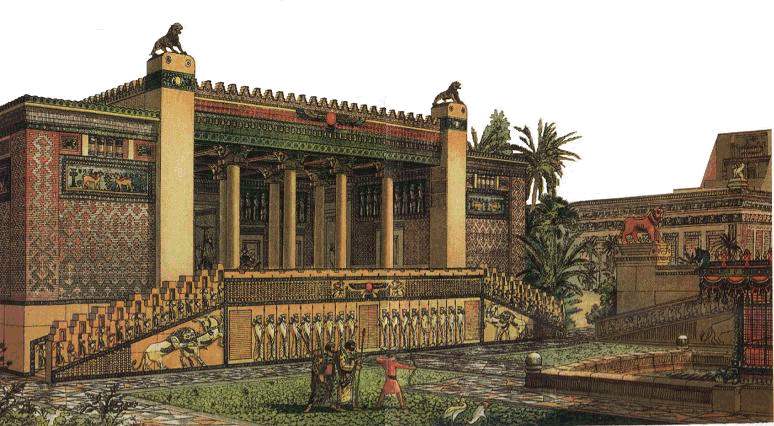
Persian carpets: 6th century BC
Persian emperors of the 6th century BC are among the first to make a display of lavish floor coverings. Carpets become one of the characteristic art forms of people living on the high plateau of west Asia, from Turkey through Iran, where winters can be extremely cold.
They are a particularly important form of wealth and comfort for the nomadic tribes which live in these regions and in the steppes to the north. One of the earliest true carpets to survive (woven with a knotted pile, and Persian in origin) belongs to a tribal ruler in about 500 BC. It is discovered in his frozen tomb at Pazyryk.
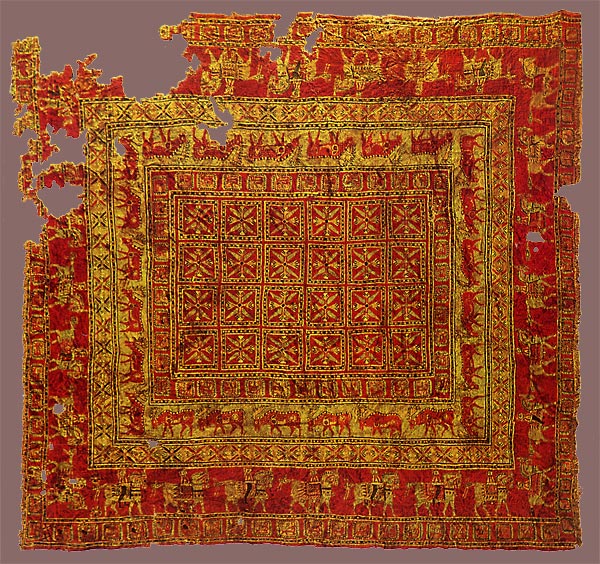
Darius and the Greeks: 514-486 BC
Amid all the successes of Darius's reign, his only real failure is at the hands of the Greeks.
It is one of profound significance for Persia's future. Since about 545 Greek-speaking Ionia (modern southwest Turkey) has been part of the Persian Empire. To protect this western region against nomads raiding from the north, Darius attempts in 514 to extend his power in this direction. He crosses the Bosphorus and pushes northwest. By the time he withdraws, Thrace and Macedonia are within the empire. Greece itself is now clearly under increasing threat from Persian intentions.
In 499 BC the cities of Ionia rebel against their Persian satrap. They are supported to a limited extent by Athens. The rebellion continues fitfully until finally put down in 493. But this region is now established as an area of friction between Persia and Greece. Geographically Ionia seems a natural extension of Persia's great land empire. But culturally the Ionians are linked to all the other Greek-speaking peoples round the Aegean Sea.
Athens becomes the main target of the Persian emperor's hostility - partly because of her support for the Ionian rebels, but also because the tyrant Hippias, expelled from Athens, is at the Persian court offering treacherous encouragement. In 490 Darius launches his attack.
The astonishing Greek victory at Marathon causes the Persians to withdraw. They have every intention of returning. But Darius dies in 486 and his death delays the renewed invasion of Greece. It is eventually launched in 480 by Darius's son and successor, Xerxes I. It has an early success (the capture and destruction of the city of Athens) but soon ends like its predecessor in total disaster, after defeat at Salamis and Plataea.
The defiance of the emperor by the small independent Greek states severely damages Persia's aura of invincibility - a significant loss in the difficult matter of controlling any far-flung empire.
Lesser emperors: 486-334 BC
The reign of Xerxes marks a change in the ruling house of Persia, following a pattern familiar in the story of many empires. The hard men who create empires tend to be followed by descendants growing up in isolated splendor, pampered by palace eunuchs and surrounded by intrigue and corruption.
Xerxes is murdered in 465 by a palace official, and two of his successors in the following century suffer the same fate. Meanwhile other emperors are weakened by a succession of rebellions - usually by ambitious provincial satraps, but on one occasion by the emperor's younger brother.
Cyrus and Xenophon: 401 BC
The attempt by Cyrus the Younger to seize the Persian throne (from his elder brother Artaxerxes II) is famous, beyond its importance, because it is the subject of the world's first book of eyewitness history.
In 401 Cyrus gathers at Sardis (in western Turkey) an army of 10,000 Greek mercenaries. Among them is Xenophon. Cyrus marches east with his army. Only when he reaches Mesopotamia does he reveal to the Greeks that his treacherous purpose is to topple his brother. They meet the imperial Persian army at Cunaxa, and in the battle Cyrus is slain. The defeated Greeks are a thousand and more miles from home. Xenophon, in his Anabasis, tells the story of their five-month trek to safety.
The main effect of the escape of Xenophon and his army, from a distant and supposedly powerful Persian province, is on the Greeks rather than the Persians. The gossip now in the streets of Greece, full of exciting anecdote and often based on direct personal experience, is that the great empire to the east is soft-centered.
The smoldering Greek resentment of Persia, the bully of the neighborhood, is eventually carried forward into decisive action by the Macedonians - themselves rough provincials in the eyes of civilized Greece. In 334 Alexander the Great marches east from Macedonia and crosses the Hellespont, entering the empire now ruled by Darius III.
The destruction of the Persian Empire: 333 - 330 BC
Within a mere eighteen months Alexander has cleared the Persians out of Anatolia, which they have held for two centuries. The conqueror now moves south along the coast through present-day Syria, Lebanon and Israel. The ports here are the home bases of the Persian fleet in the Mediterranean. By occupying them he intends to cripple the fleet and deprive it of contact with the cities of the empire, including Persepolis. Most of the Phoenician towns open their gates to him. The exception is the greatest of them all, Tyre, which he besieges for seven months.
By the autumn of 332 Alexander is in Egypt. The Persian governor rapidly surrenders.
In the spring of 331 Alexander is ready to move northeast into Mesopotamia, where he meets and defeats the Persian emperor Darius in the decisive battle of Gaugamela. His way is now open to the great Persian capital city of Persepolis.
In a symbolic gesture, ending conclusively the long wars between Greeks and Persians, he burns the palace of Xerxes in 330 (legend maintains that he is prompted to this act of vandalism by his Athenian mistress, Thaïs, after a drunken party). To make plain who now rules the Persian Empire, Alexander adopts the ceremonial dress and court rituals of the emperor.
The legacy of Alexander: from 323 BC
Alexander dies in Babylon in 323. He has no heir, so after his death his generals set about carving up the new Hellenistic empire.
After prolonged warfare two of them emerge with sizable portions. Ptolemy establishes himself in Egypt. And Seleucus wins control of a vast area - Anatolia, Mesopotamia, Persia and the eastern part of the empire, including at first even the territories in India.
The region acquired by Seleucus proves impossible for his descendants to hold, even with the help of New Greek cities. These are established in strategic places and are populated with soldiers and administrators imported from Greece and Asia Minor.
As early as 305, within the lifetime of Seleucus, the Indian conquests of Alexander the Great have to be abandoned. Within the next half century much of Anatolia asserts its independence (of many small new states Pergamum is the most significant), soon to be followed by Parthia and Bactria to the northeast. But the eastern Mediterranean and Mesopotamia are at first secure.
New routes to the west: from 300 BC
The presence of Greeks in Mesopotamia and the eastern Mediterranean encourages a new trade route. To ease the transport of goods to Greece and beyond, Seleucus founds in 300 BC a city at the northeast tip of the Mediterranean. He calls it Antioch, in honour of his own father, Antiochus. Its port, at the mouth of the river, is named after himself - Seleucia.
Here goods are put on board ship after arriving in caravans from Mesopotamia. The journey has begun in another new city, also called Seleucia, founded in 312 BC by Seleucus as the capital of his empire. It is perfectly placed for trade, at the point where a canal from the Euphrates links with the Tigris.
Doura-Europus, a frontier town: from the 3rd century BC
The first major stopping point for the caravans on the route from Mesopotamia to Syria is the old Babylonian town of Doura, on the west bank of the Euphrates. Rebuilt by Seleucus in about 300 BC, it is given the new name of Europus.
This settlement later becomes of great importance as a frontier post, when the Euphrates is the boundary between successive empires.
The other great staging post on the route to Antioch is also an important site, and today a much more visible one. It is Palmyra, famous as one of the great ruined classical cities.
From Doura-Europus, on the Euphrates, the caravans strike west through the desert to the Mediterranean coast. Palmyra is an oasis half way across this difficult terrain. Its wealth derives from its position on the east-west axis from Persia to the coast, in addition to being on the older routes up from Mesopotamia. In the 1st century BC, when Palmyra is on the verge of its greatest prosperity, a rich new supply of goods begins to arrive from the east along the Silk Road. But by now neither Persia nor Mesopotamia are Greek.
The dwindling Greek presence: 3rd-1st century BC
From the middle of the 3rd century BC the Seleucid Empire is under constant pressure from Ptolemaic Egypt in the south, from the increasing might of Parthia to the east and from Rome, a new power in this region, to the west. It is gradually reduced until it comprises just Syria.
Eventually Rome and Parthia squeeze the Seleucids to extinction. Their dynasty officially lasts until the Romans annexe Syria in 64 BC. The Euphrates then becomes the dividing line between the Mediterranean empire of Rome and the Persian empire of the Parthian's. The frontier town of Doura-Europus, on the Euphrates, bears witness to the rich blend of cultural influences in this historic region.
The Parthians: 3rd century BC - 3rd century AD
The origins of the Parthian dynasty lie with a tribe of nomads, the Parni, in the steppes near the Caspian. After gradually infiltrating to the south, they overthrow the Seleucids and take power as a royal house in Parthia in about 247 BC. The founder of their line is Arsaces I, and the dynasty is sometimes known as Arsacid.
The Parthians never lose touch with their origins as horsemen of the steppes, and their brilliance in fighting from the saddle is a large part of their fame. It brings them a great victory over the Romans at Carrhae in 53 BC. The 'Parthian shot', in which a horseman fires an arrow over the rump of the horse as he gallops away, becomes a favorite image of the ancient world.
An agreed boundary with the Parthians is one of the achievements of the peaceful foreign policy of the emperor Augustus. He even recovers for Rome the imperial standards captured by the Parthians at Carrhae, the loss of which has been a cause of deep shame. Negotiations result in the Parthians recognizing Roman sovereignty over Armenia, while Rome agrees not to challenge Parthian rule in Mesopotamia east of the Euphrates.
These friendly arrangements do not prevent Rome from meddling in the affairs of the Parthian royal dynasty by underhand means, in the extraordinary affair of an Italian slave girl, Musa.
Pressure from the east: 1st century BC - 1st century AD
While engaged in the evenly matched tussle with Rome in the west, the Parthians are subject to much more relentless pressure from the east. Just as the Parthians themselves moved down from the steppes into Persia, nomadic tribes from north of the Himalayas are now pressing on the eastern part of the empire. By the 1st century BC the Yueqi are settled in Bactria.
This pressure from the east, combined with the lush appeal of Mesopotamia, has the effect of transferring the centre of Parthian rule westwards. By the 1st century BC they are developing Ctesiphon as their capital, on the opposite bank of the Tigris from the Greek city of Seleucia.
Decline of Parthia: 2nd - 3rd century AD
On several occasions during the 2nd century the Romans invade Parthia, sometimes even reaching Ctesiphon and beyond. They are never able to hold for long any territory which they gain beyond the Euphrates, but their incursions weaken the Parthian royal dynasty.
In keeping with their nomadic origins, the Parthians rule in a feudal fashion - as leaders of a loose hierarchy of powerful local dynasties. One such dynasty that of the Sassanians, brings the Parthian empire to an end. Repeating a pattern eight centuries old (when Cyrus overthrew the Medes), the rebellious feudal vassal comes from the most ancient land of Persia, the kingdom of Fars, known at this time by the Greek name of Persis.
The Sassanians: 3rd - 7th century AD
The founder of the Sassanian dynasty, Ardashir, has strong links with the ancient Persian religion. His father is in charge of a temple to Zoroaster in the region of the ruined Persepolis before he kills the local ruler and takes his place. Ardashir inherits this petty kingdom and enlarges it - by defeating and killing local princes - until he is in a position to be crowned king of Fars in about 208.
A continuous process of slow expansion, at the expense of the Parthians, brings him to Ctesiphon. He enters the Parthian capital in triumph in about 224 and is crowned 'king of kings'. The new king is proud of one particular ancestor, Sassan; his dynasty becomes known as Sassanian.
Near Persepolis, at Naqsh-e-Rustam, Ardashir commissions a great relief sculpted high in the rock face. It depicts him on horseback, with a dead Parthian beneath his horse's hooves, while he receives the royal crown from Ahura Mazda.
With the restoration of the first authentically Persian dynasty since the Achaemenids, the cult of Ahura Mazda becomes again the official state religion. There is now a ritual hierarchy throughout the empire, with chief priests for each major district and a supreme priest wielding overall authority.
In the following centuries the Sassanian empire is at its greatest extent in two periods: under Ardashir's son Shapur, when Antioch is captured and the Roman emperor Valerian taken prisoner (in 260); and in the time of Khosrau I, who raids into Byzantine Syria, again takes Antioch (in 540) and carries off its famous craftsmen to work on his palace at Ctesiphon (famous for its spectacular Spring Carpet). In both reigns the empire includes territories across the Persian Gulf, in Arabia.
But though there may be brief triumphs, as in the double capture of Antioch or similar Roman successes at Ctesiphon, the overall effect of this long contest between Persia and Rome (or Byzantium) is debilitating to both.
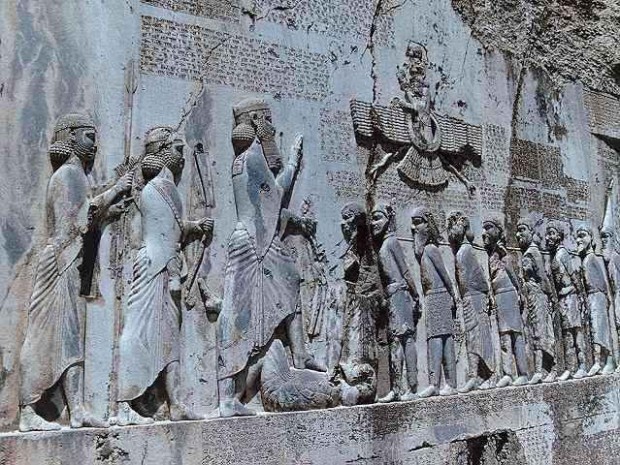
Byzantium and Persia: 6th - 7th century
The final and most destructive chapter in the rivalry between the Byzantine empire and Persia begins in an improbable way. In591 both emperors find themselves fighting on the same side.
Khosrau II has fled from Persia after the murder of his father. He enlists the support of the Byzantine emperor, Maurice, who marches east to restore Khosrau to his inheritance - in return for some useful territorial concessions in Armenia and Mesopotamia. The result is peace between the two sides until 602, when Maurice is murdered in a Byzantine upheaval. Khosrau, seeing his own opportunity, moves to avenge his friend's death. In the next few years the Persians devastate the Byzantine cities of the Middle East.
The first Christian city to fall to Khosrau's armies is Antioch, in 611. Damascus follows in 613. In the spring of 614 a Persian army enters Palestine and moves through the countryside, burning churches. Only the church built by St Helena in Bethlehem is spared; the Persians recognize themselves in the costumes of the Magi, seen bringing their gifts to the infant Jesus in a mosaic above the entrance.
The army reaches Jerusalem in April. The Patriarch urges the inhabitants to surrender, so as to avoid bloodshed, but they resist for a month. When the city falls, it is said that some 60,000 Christians are massacred and another 35,000 sold into slavery.
From the point of view of the Christian hierarchy, far away in Constantinople, the Persians commit one even greater affront. After sacking Jerusalem, they carry off to Ctesiphon the most holy relic of Christendom, the True Cross of Christ.
Its restoration to Jerusalem becomes an urgent matter of state.
Recovering the relic: 622-629
Under the emperor Heraclius, Byzantium has been quietly regaining its strength. In622 Heraclius feels ready to take the field against the Persians. His successes are as rapid and spectacular as the reverses of the previous decade. By 624 he has swept through Asia Minor and Armenia to reach Azerbaijan, to the north of Persia between the Black Sea and the Caspian.
Here, as if avenging the violation of the True Cross, he destroys one of the most sacred fire temples of Zoroastrianism.
In the next few years the swings of fortune become even more extreme. In 626 a Persian army reaches the Bosphorus, but fails to cross the water to support a siege of Constantinople's massive walls by a barbarian horde of Slavs and Avars. In 627 a Byzantine army under Heraclius penetrates Mesopotamia far enough to defeat the Persians at Nineveh and destroy Khosrau's palace at Ctesiphon.